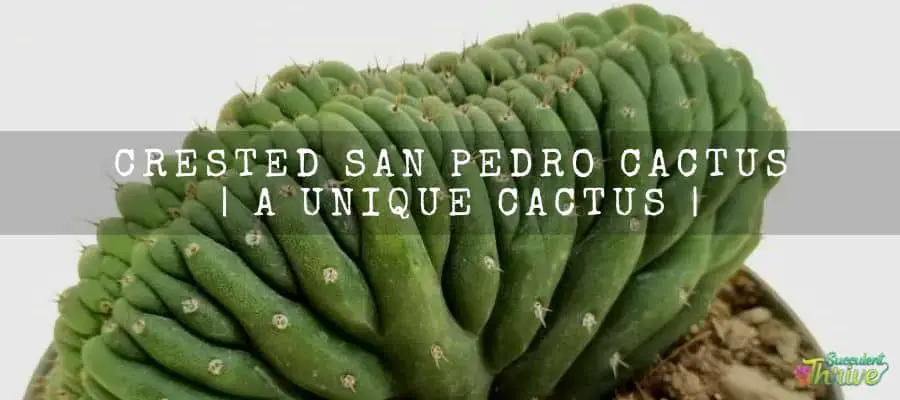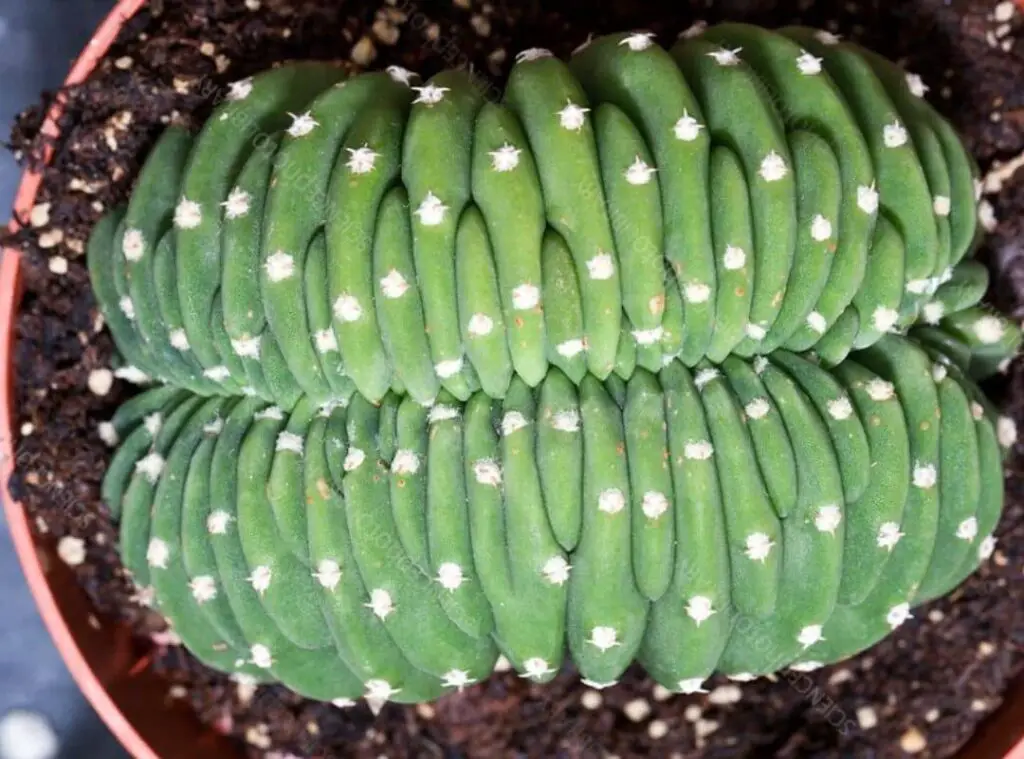Crested San Pedro cactus is a rare and crested form of Echinopsis pachanoi plants. If you are unfamiliar with the term called crested, it is the process of how you make a plant grow abnormally.

If you are a succulent enthusiast, you might already be aware what crested cacti are. One might find it an abnormal process. However, the purpose of doing so is to develop plants with amazing shapes and a unique beauty. There are over 100 crested plant species in the world.
The best example we could consider under these plants are the Crested San Pedro cactus which we are going to discuss in detail here.
Crested San Pedro cactus are special in many ways. For example, they can withstand a wide range of conditions. Further they can tolerate more water and fertilizers than other cactus.
These plants may develop small spines. As such you can easily handle them too. So, if you have kids or pets at home, you can grow them without any hassle as it is very unlikely that those small spines will damage them. Furthermore, even a fresher in gardening can start cultivating them.
Echinopsis pachanoi or Trichocereus pachanoi is the scientific term for these plants. So, from this article, we will be explaining how you should identify the plants, the care tips, the propagation method and so on.
If you are already interested in learning about these beauties, you can keep on reading this article.
How do I identify Crested San Pedro cactus?
If you are wondering how to identify the Crested San Pedro cactus, they would usually come up with a fan shaped stem. It is in fact an outcome of the process called cristation.
Crested San Pedro cactus would be prominent in green to bluish green. They would grow as tall as 1 meter ( 3.3 feet ). They would further tend to form brain like mounds as they grow.
In addition to that, you could spot them carrying areolas too. The areoles would develop in white. Further they may also form multiple spines as well.
Those spines would attain a length of 2cm ( 0.8inches ). Besides you could spot them in dark yellow to light brown as well.
Chances are that Crested San Pedro cactus may produce flowers in white. Those flower blossoms would be somewhat large and carry a sweet fragrance as well.
If you had grown the Crested San Pedro cactus naturally without subjecting them for cristation, they would usually grow into a usual tree shape. Further they may also carry several side branches too. Those branches would form from the lower trunk.
Cristation would make the plant’s main stem to take a look of a brain. If you had placed them to grow in a vertical manner, you could see a flattened tip which would form with the look of a folded ribbon.
Growth rate
Crested San Pedro cactus are rapid growing plants.

One look care guide
| Botanical Name | Trichocereus Pachanoi f. Cristata |
| Common Name | Crested San Pedro cactus |
| Plant Type | Cactus |
| Mature Size | height of 1 meter |
| Sun Exposure | Full sunlight to partial shade |
| Soil Type | Well draining |
| Soil pH | Acid, Alkaline, Neutral |
| Flower Color | White |
| Hardiness Zones | USDA hardiness zones 8b to 10 |
| Native Area | N/A |
| Average price | 55 USD |
How do you take care of the Crested San Pedro cactus?
Light Requirement
Crested San Pedro cactus require full sunlight in the morning hours to thrive well. Having said that, it would be better to expose these plants to partial shade during the summer days as the sunrise would be too intense during these days.
Instead, they would want a light shade during summertime. Consider that you have shifted the plants indoors to protect them from the frost, then you need to ideally grow them exposed to grow lights.
Unless they will be running short of sufficient sunlight. Further they would tend to develop lengthy stems as well.
When you bring them indoors, you need to slowly acclimate the plants for dark cooler conditions unless they would tend to stretch and develop aesthetically less appealing plant parts.
Temperature and humidity
Crested San Pedro cactus are a little cold hardy up to 5 degrees Celsius. However prolonged exposure for colder conditions would be harmful for them.
Ideally you need to grow them exposed to warmer temperatures all year long. If extreme winter conditions are predicted, you need to bring the plants indoors to protect them from such unhealthy conditions.
Is it cold hardy?
These plants have a cold tolerance up to 5 degrees Celsius.
Growth Zone
The conditions in USDA hardiness zones 8b to 10 would suit these plants the best. If you are someone who lives in these zones, you could grow them outdoors all year long.
Watering Requirement
In terms of watering the Crested San Pedro cactus during summer, you should water them once every two days.
As aforesaid these plants are more tolerant of watering compared to other succulents. However, you need to still ascertain that their soil is dry from the previous watering session and only then you need to commence watering the plants.
Make sure you water them thoroughly when watering them. A good watering would make them look plump in appearance.
However, do not make their soil too soggy or exposed to excess water as it would be harmful for the plant’s overall growth.
Soil Requirement Type / pH
When it comes to the right soil mix of these plants, they would opt to grow in a fast-draining soil mix. Ideally it has to be a mix of clay, sand and loam.
Pot size Potting and Repotting
The right pot to grow these would ideally be a porous one. Additionally, it has to have one or two draining holes too.
The draining in the pot is a crucial one as only then they can drain the excess water away from the pots. The porosity of the potting material is also crucial as only then the excess water could evaporate faster from the pots.
Repotting could be done periodically ideally once every other year. In addition to that, you need to consider transplanting the plants when they are suffering from a pest attack, diseases. Further, if you spot the plants have overgrown from the pots you can consider repotting the plants.
To repot, you need to first remove the plants from the pots and clean the older soil around the roots of the plants, next check whether your plants are doing healthy and whether you could witness any rotten decaying plant parts.
If you come across any decaying plant part, you need to cut them off and treat them with fungicides. After that let them wither for a couple of days and pot them in slightly bigger pots.
Where to Plant
Crested San Pedro cactus would survive in any location as long as they can gain ample sunlight.
Fertilizer and time of year
Fertilizing the plants during their active growing season would be beneficial for the vigorous growth of the plants. It would help the plants to develop a lush growth. You can make use of cacti fertilizer to feed the plants. Never apply the fertilizers during winter.
Flower
Crested San Pedro cactus may bear flowers in white right above the areoles. Those flowers would be about 20 cm in Dima tare.
Dormancy
Crested San Pedro cactus go into dormancy during winter.
Toxicity
Crested San Pedro cactus plants are non toxic as there are no reports of toxicity.
Common bugs and illnesses
Crested San Pedro cactus may have to combat fungal infections on and off. If there are favorable conditions for them, you may have to deal with these quite often. Waterlogged conditions in the soil which could be the main culprit all the time.
Crested San Pedro cactus benefits
Crested San Pedro cactus would be an excellent choice for container gardening. They would add so much grace and glamor to your entire set up.
How to propagate Crested San Pedro cactus
You can use the offsets propagation method to make new plants. You could spot them carrying offsets around the base of the mother plants and all you have to do is just remove them from the main stem and grow them as individual plants in the pots.
In addition to the offset’s propagation method, you could use the cuttings propagation method also for the propagation process.
If you wish to practice the stem cutting propagation method, you need to obtain the cuttings and allow them to dry for a couple of days.
You can place them on a dry towel to do this task. After a few days’ time you could witness how they have developed a callous.
When they have developed callousness, you can dip them in a rooting mixture and then plant them in a fast-draining soil mix.
Conclusion
Before concluding this, Crested San Pedro cactus are such great plants to have. They require easy maintenance from you and If you assure that you fulfill those, they will flourish and reward you with such adorable plants in return. So, Happy cultivating with Crested San Pedro cactus !
Read Next : Coral Cactus Growing Leaves ( Don’t Worry It’s Not a Problem )
